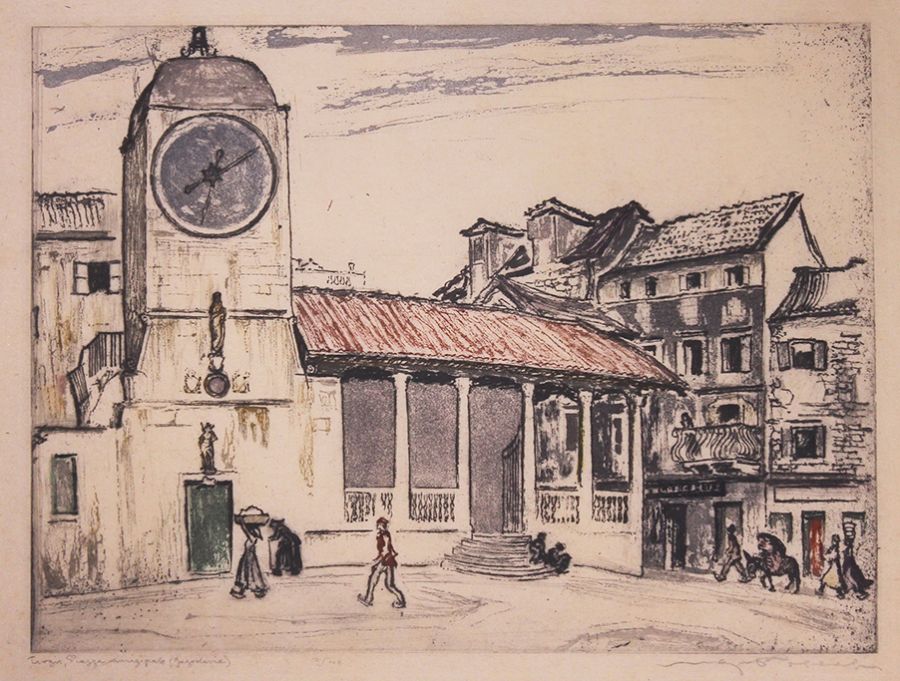Trogir, Piazza (Yugoslavia) is an etching, soft-ground etching, and aquatint printed in color circa 1930 by Czech born artist Max Pollak. It is pencil signed, titled and editioned 7/100. Trogir, Piazza was printed by the artist on ivory wove paper and the platemark measures 11-13/16 x 15-13/16 inches.
Pollak’s etching depicts the central square with the Trogir loggia and clock tower. The clock sports a light blue-colored clock dial and the clock tower was once part of the church of St. Sebastian. There are differing opinions as to the century in which these were built, some state the fourteenth and others state the fifteenth. The loggia was probably used as a courtroom in Renaissance times and features reliefs that were made by Nikola Firentinac and Ivan Mestrovic. St. Lawrence Church, a thirteenth century landmark, is also situated on the central square.
Trogir’s history began around the third century BC with its founding by Greek colonists. It has a long history of invasions and destruction. After World War I, Trogir became part of the State of Slovenes, Croats and Serbs and subsequently the Kingdom of Yugoslavia. During World War II, Trogir was occupied by Italy but liberated in 1944 when it then belonged to the second Yugoslavia. Since 1991, Trogir has belonged to Croatia.
Max Pollak, painter and printmaker, was born in Prague, Czechoslovakia in 1886. He was raised in Vienna and, in 1902, he entered the Vienna Academy of Art where he studied under William Unger and Ferdinand Schmutzer. In 1912, Pollak traveled to Italy, France, and Holland to study and paint. During the First World War, he was appointed painter of the Austrian Army.
He immigrated to the United States in 1927, living for a time on the east coast where he produced a series of color aquatints of New York, Cincinnati, and Detroit. His first exhibition was at the 57th Street Art Gallery in New York and he was commissioned by Theodore Dreiser in 1929 to illustrate his book, My City. In 1938, Pollak and his wife, Friedl, moved to San Francisco, California. Pollak was inspired by his new city and its environs and produced beautiful views of San Francisco Bay Area. Later travels included trips to Mexico and Guatemala.
Max Pollak was a member of the Chicago Society of Etchers and the California Society of Etchers. His work is represented in the collections of the Magnes Collection of Jewish Art and Life, Berkeley, California; the Jordan Schnitzer Museum of Art, University of Oregon, Eugene; the British Museum, London; the Metropolitan Museum of Art and the New York Public Library, New York; the Oakland Museum of California Art; the Fine Arts Museums of San Francisco, California; and the Smithsonian American Art Museum, Washington, D.C.



